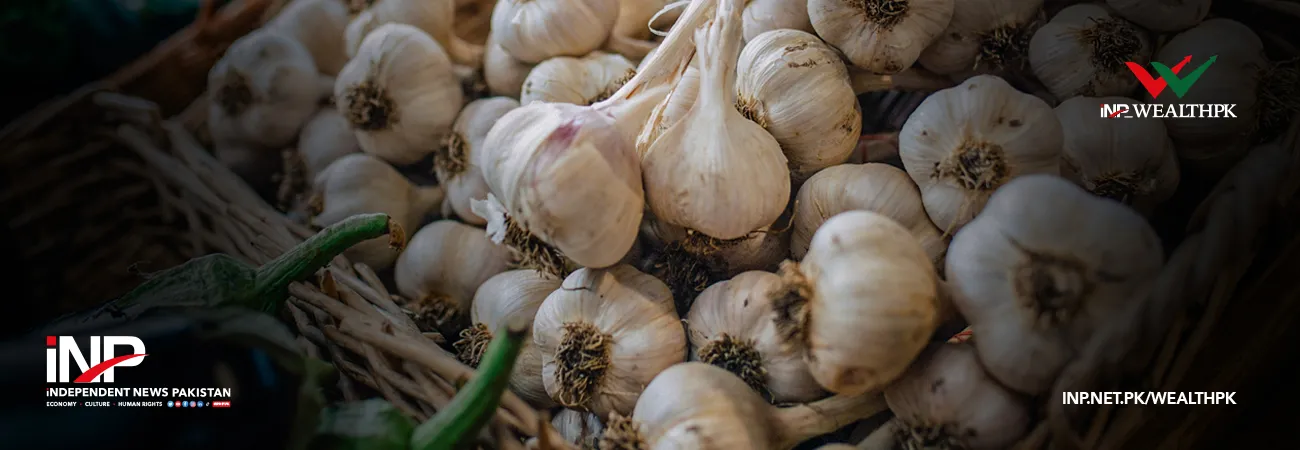INP-WealthPk
Azeem Ahmed Khan
Pakistan plans to become an exporter of garlic in the coming years, ultimately reducing import costs and saving foreign exchange, with substantial production of a new variety. The NARC-G1, developed by scientists at the National Agriculture Research Centre (NARC) in Islamabad, stands out as the most lucrative garlic variety in the country. Agriculture experts have emphasised the importance of cultivating the distinct garlic variety across the country due to its exceptional yield and income potential compared to other available varieties. Pakistan Agricultural Research Council (PARC) Chairman Ghulam Muhammad Ali, commenting on this variety, said that due to the prevalence of small land holdings among Pakistani farmers, often limited to one or two acres, the primary objective of NARC-G1 is to achieve a maximum yield within a confined space.
He said this variety has so much potential that it can yield double or even triple the produce. He said the inception of NARC-G1 involved hectic efforts of scientists because it takes about seven to 10 years to adopt a seed. The selection of the seed involves meticulous comparison with existing market bulbs, a thorough evaluation of local and imported materials, and an assessment of environmental factors. This strategic move was also necessitated by Pakistan's substantial expenditure on garlic imports. The cultivation of NARC-G1 holds the potential to mitigate garlic imports in Pakistan, which are necessitated by inadequate local yields. For this reason, according to statistics from the International Trade Centre, Pakistan imported 61,688 tonnes of garlic worth $68.7 million during 2021, although the import value was even greater in 2020, reaching $102 million.
Focusing on high-yield garlic varieties like NARC-G1 can help bridge the yield gap and reduce import dependence. Ghulam said that with a remarkable yield potential of up to 225%, the NARC-G1 enables farmers to garner more than double the investment in cultivation costs. Its per-acre yield ranges from 6 to 9 tonnes, attributed to its larger seed or bulb size, thicker cloves, and greater weight compared to conventional crops, besides the plant’s improved height, he said. The locally produced garlic weighs around 30-50 grammes on average, while NARC-G1 boasts a weight of 250-450 grammes. So, by adhering to optimal growth conditions and cultivating practices, Pakistani farmers can maximise garlic yield and quality. Furthermore, this variety has exhibited robust resistance against crop diseases. Garlic is globally recognised as a remedy for diverse ailments and physiological conditions.
It is also used for medicinal purposes, effectively combating diseases and inhibiting bacterial growth and infections. The PARC chairman said when NARC-G1’s fibre, copper, magnesium, and iron concentrations were compared to those of other commercially available garlic types, they were found to be twice as high. Ghulam Muhammad said the cultivation of NARC-G1 commences in September or October and culminates in harvesting during April and May. Soft soil is essential for NARC-G1’s proper bulb development, as it forms within the soil. For optimal results, he recommended a plant-to-plant spacing of four inches and a row-to-row distance of one foot to prevent reduced yields due to excessive spacing. Agricultural experts strongly advocate for transitioning from traditional farming methods to modern techniques, such as the use of latest machinery, drones and drip irrigation alongside the adoption of high-quality seeds to make the country self-sufficient in agriculture production.
The NARC-G1 has consistently displayed excellent performance under diverse weather conditions through rigorous testing across various regions, from Karachi in the south to Gilgit in the north. Major contributions to Pakistan's garlic production come from Punjab and Khyber Pakhtunkhwa provinces, accounting for over 79% of the total output. An additional advantage of NARC-G1 is its extended shelf life. When stored in a well-ventilated and shaded environment with the stalk intact, NARC-G1 garlic remains unspoiled for up to a year, demonstrating resistance to sprouting even in household or warehouse storage. Garlic holds a significant place in Pakistan's culinary landscape, following onion as the second most widely cultivated allium. It is cherished for enhancing the flavour of diverse dishes and is grown throughout the country. Notable garlic seed varieties in Pakistan include Italian/Iranian, Chinese, MJ-84, JS-1, Lehsan White, Pakhal Giant, NS-756, Desi Gulabi, and NARC-G1.
NARC G-1 has long been grown and distributed as a seed in Pakistan, but it has not entered the retail market yet. So, the prices of the seed have been escalating due to surging demand. The cost of NARC-G1 garlic seeds in Pakistan varies according to region and season, ranging from Rs1,800 to Rs2,000 per kg. The cost of garlic seeds constitutes a significant portion, accounting for more than 70% of the total expenses. This proportion acts as a primary entry barrier for small-scale farmers. However, seed-related assistance is a one-time necessity, as farmers can utilise their own harvested seeds for subsequent crops. Moreover, according to an agriculture scientist, NARC G-1 is now ready to shift from seed mode to general farming mode, as production has almost met the demand for seed making. He said the seed cost this year is expected to be low compared to previous years.
Credit: INP-WealthPk













